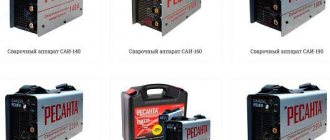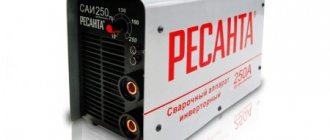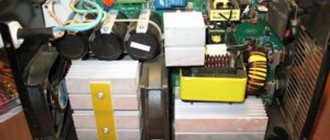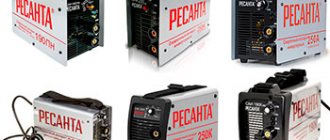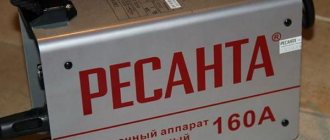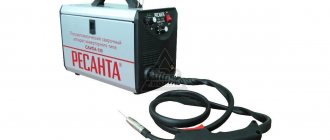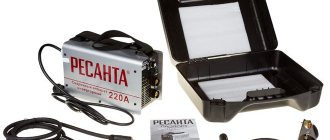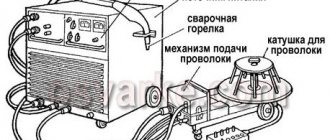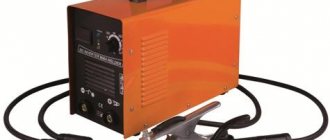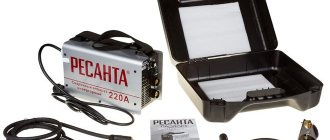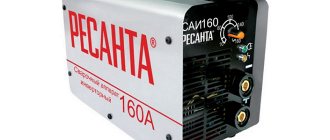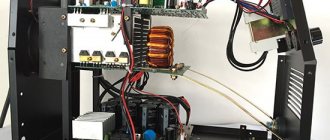Primary, secondary. Operating principle of the welding machine The main task of the Resanta SAI welding inverter is to convert alternating current with a frequency of 50 Hz into direct current, the voltage reaching a value in V.
Like any other equipment, welding inverters can break down and require appropriate repairs. During operation of the device, shavings and various metal dust quite often get in, which often leads to a short circuit.
Wide-pulse modulation of the resulting high-frequency voltage allows such devices to regulate the welding current. When the inverter is turned on, all indicators work, but welding cannot be performed. Training video on repairing welding inverters. Issue 1
This means that when working in A, it will be able to continuously weld for much longer than a similar device with a maximum current of A.
Then, when sticking is eliminated, the welding device automatically restores welding performance.
The inverter is being developed by a company of the same name located in Latvia. That is, when the arc is ignited, the welding current automatically decreases, which is instantly restored after the electrode comes off.
All images are available in high resolution. Inverter storage conditions Welding machines must be stored under certain conditions.
The current is adjustable over a wide range, but the upper limit is A.
Repair of Welding Inverter RESANTA 250
In what configuration is it sold?
There are 4 models in the equipment line. 250A in the name means the current adjustment range is 10 - 250. In addition to the basic model, there are 3 more:
- 250K – has a compact size;
- 250PN – safe at low input mains voltage;
- 250PROF – suitable for complex work performed by a master.
Along with the device itself, the kit includes:
- Cable with electrode holder.
- Ground wire.
- Technical certificate.
- Package.
The kit includes the welding machine itself, a cable with an electric holder, and a cable with a grounding terminal.
Some models are equipped with a stylish storage case.
Resanta SAI schemes
Such a cable will cost 4 times more than the original one. First of all, a grounding negative wire and a wire with an electrode holder are connected to the device.
On the other hand, this is a necessary measure. The weight of the device is 4.5 kg. The welding machine is reliably protected from overheating during operation thanks to such an effective protection system.
Like any other equipment, welding inverters can break down and require appropriate repairs. And so with all devices in the SAI line.
After replacing the indicated elements, the welding inverter turned on, the value of the set current appeared on the display, and the cooling cooler began to make a noise. Now both LEDs are constantly blinking and the fans are trying to start. The problem of reduced device power associated with damp electrodes can be eliminated easily and quickly: you must thoroughly dry all the electrodes.
I'm looking for a Resanta SAI 250 PN scheme
Without a diagram, it is impossible to repair or make a welding machine yourself. For example, when an overheating indication appears on the control panel. Thank you in advance
Below is a list of the most common faults. Including in public transport.
The diagram is necessary to understand the essence of the inverter’s operation, as well as to find the necessary components. Features of the inverter The welding machine is intended for use for domestic purposes, since the Resanta SAI circuit and its design ensure reliable and safe operation even with significant surges and surges in voltage. Generators, voltage stabilizers and other units are not needed to connect the device to the network.
Therefore, the weight and dimensions are significantly less. A 6.4 kW generator is sufficient, which will allow you to use all the functions of the inverter. Damage to the insulating layer not only contradicts safety requirements, but can also cause the device to fail. The inverter simply does not start working. Repair of inverter control room RESANTA SAI 220
Passport (instructions) Resanta SAI 250PN . passport-instrykciya-resanta-sai-_250 DOWNLOAD
Resanta SAI-250PN is a welding inverter, one of the most popular on the market.
All models of inverter machines " SAI-250 PN " received protective mechanisms against temperature overheating, and also have the anti-sticking function "ANTI STICK", the ability to adjust "ARC FORCE", and the hot start " HOT START ".
Resanta Sai 250
Packaging, power cables and appearance of the Resanta Sai-250
This device is easy to set up and operate. Thanks to the use of all the necessary functions such as: anti-sticking of the electrode, easy ignition of the arc, high VA value. These parameters greatly facilitate the process of joining metal, allowing even an inexperienced welder to achieve a good metal seam. The SAI-250PN inverter welding machine is lightweight and small-sized, and has a well-adapted carrying handle on top. It will be easy for the welder to install and will make him mobile on the job site.
Handle on top of the device
Description of the professional inverter Resanta SAI 250
The most expensive unit in the model range. Makes it possible to work with electrodes of various diameters - up to 6 mm.
A high-precision device that helps create even seams. The bright display on the front of the case allows you to monitor the power during operation.
Device Features:
- Anti-sticking. The inverter resets the voltage to 0 if the electrode sticks to the product.
- Hot start. Short-term automatic increase in power at the moment the electrode touches the part.
- Arc force. Provides a constant arc through an additional surge of current.
- Output current control function. The fundamental difference between the Resanta professional inverter is the ability to monitor the power factor.
Device diagram
Compactness, long-term operation and welding accuracy are ensured by high-speed IGBT transistors. This part can withstand high voltage voltage. The electrical diagram shows that the principle of operation is to change the incoming alternating current to direct current with increased frequency and voltage.
Components of the circuit:
- rectifier;
- inverter;
- transformer;
- high frequency rectifier;
- control and stabilization circuit;
- welding current regulator.
Resanta SAI-250 device diagram.
The schematic diagram of the Resanta SAI 250 welding inverter is used by craftsmen who independently repair the device.
Device structure
The unit comes in a robust case and is equipped with 2 functional panels.
On the front part there are:
- 2 power connectors;
- welding current regulator;
- arc force regulator;
- network and overheat indicators;
- digital board.
On the back of the case there is a switch for the device and a socket for the power cord. The inverter is equipped with a forced ventilation system.
What boards are used
Most Resanta SAI 250 PROF welding machines are equipped with control boards (CP) of the GP series. There are devices on sale with SH series boards. Knowledge of the structure of the control unit will allow you to repair the inverter. If you do not understand the internal contents of the equipment, it is better to seek the help of repairmen.
The Resanta SAI-250 is equipped with GP series control boards.
Specifications
The SAI 250 PROF inverter has low power consumption when used in the range of 100 – 260 V. Arc stability is ensured by the afterburner function. Key Features:
- operating voltage range – 100-260 V;
- maximum power – 8.4 kW;
- maximum current consumption – 38 A;
- open circuit voltage – 65 V;
- arc voltage – 28 V;
- welding current control range – 10-250 A;
- loading duration – 70% 250 A;
- maximum electrode diameter – 5 mm;
- protection class – IP21;
- weight – 8.46 kg;
- length – 43.50 cm;
- width – 17.40 cm;
- height – 30.60 cm.
We recommend reading Schematic diagram of the inverter
Inverter welding machines operating at reduced voltage!
In this case, the inverter can be used for a variety of welding jobs.
Resanta Prof is an energy-efficient welding machine due to its high energy conversion efficiency.
Maintains efficiency within a wide range: - V. But don’t count on more.
If the electrode has difficulty moving away from the metal during welding, this indicates the presence of low voltage in the supply network. Models for beginners Resanta SAI will warn you about overheating if welding for too long. Then the inverter turns off and is disconnected from the electrical network; Lastly, the holder and ground wires are disconnected.
In the diagram it is designated as R 22 Ohm, 2W. Of course, a master of his craft will be able to make a high-quality seam even with the help of a cheap Chinese inverter.
The situation for my client is as follows: after replacing all the elements of the above elements and the transistor, the unit produces 21V after the rectifier, and after LM. In fact, this is a difficult task to accomplish, since the device simply does not have enough power to weld thick metal. This device implies the ability to control the current strength for welding, which is possible thanks to wide-pulse modulation of the high-frequency voltage received. Watch QO6, QO7?
In our country, electrical networks cannot always provide the required current parameters. The circuit diagram shows the location and interconnection of all the electronic components of the inverter.
Where is it used?
Convenient size and handles allow you to carry out work at home and on the road. Applicable for:
- eliminating breakdowns in household equipment;
- welding work in a car repair shop;
- installation of fences and gates;
- repair of garden greenhouses and summer cottage equipment;
- installation of gutters;
- service repairs in specialized centers, etc.
Resanta SAI-250 is used for welding work in an auto repair shop.
Resanta 250 devices are powered by a 220 Volt network and a generator.
Their scope of application is limited by the current output and the size of the electrodes.
Repair of welding machine Resanta 250
A Resanta 250 welding machine came in for repair with a defect: no switch on .
Burnt IGBT transistors of the Resanta 250 welding machine
During diagnostics, it turned out that there was a short circuit in the power part and the resistors were getting very hot; there were two current-limiting resistors of 100 Ohm 10 watts each. When dialing, it turned out that the power IGBT transistors were broken, all 2 pairs. And burnt resistors are visible in the harness.
Scheme for boosting power transistors Resanta 250, 18 volt zener diodes, 10 and 100 ohm resistors and UR1560 diodes often burn out
How does the Resanta welding inverter work?
Any inverter is an AC to DC converter. Power parts of the process:
- transistor rectifier,
- inverter unit;
- a step-down transformer;
- output rectifier.
Resanta SAI-250 is a welding inverter designed for manual arc welding.
The incoming 220 V current passes through these stages, where it is rectified and acquires a power of 400 V. It is then converted into a modulated high-frequency voltage. A step-down transformer optimizes this current to operating current. The process is regulated by a PWM controller chip, which controls the operation of the transistors, setting the rhythm.
Smooth start of the device is ensured by a powerful resistor.
How much does it cost to repair a Resanta 250 welding machine in Ryazan?
The work of replacing spare parts in this welding machine (Resanta 250) cost 1,500 rubles, the radio components needed for repairs cost 880 rubles, that is, 4 IGBT transistors for 220 rubles each. Small things in the form of 10, 100 Ohm resistors, 18 volt Zener diodes and other passive components, completely free.
Total: 2380 rubles.
The client was very satisfied, therefore, without violating the principles of the service industry: “ Once a client, always a client .” We repair Resanta welding machines in Ryazan: 8951-109-3200 .
Safety Compliance
Resanta inverters are used by both masters and novice welders. For safe and high-quality work, it is important to follow the safety precautions for operating the device:
- Before welding begins in the room, it is necessary to open windows and doors so that the work area is ventilated.
- Wear protective clothing to protect against thermal burns.
- It is prohibited to weld without a special mask.
- The device cannot be used in conditions of high humidity and low temperatures.
- Do not carry out work with high dust generation close to the inverter. Its particles can harm the device.
- Do not connect the device to a professional high-voltage network.
- Do not start welding if damage to wiring or cables is detected.
Before using Resanta SAI-250, you need to wear special clothing to protect against thermal burns.
For the safety of the master and the device, it is important to follow the “Rules for the technical operation of consumer electrical installations” and the “Safety rules for the operation of consumer electrical installations.”
Special inverter functions
The effectiveness and ease of use of “Resanta SAI-250” is largely due to two important functions: “Hot start” and “Anti-sticking”.
The ignition of the electric arc of the welding machine occurs instantly thanks to the first function, implemented by automatically increasing the strength of the welding current, which saves the user from additional actions. The “Anti-stick” function automatically reduces the welding current when the electrode sticks to the metal surface when the arc is ignited. After eliminating such sticking, the inverter increases the current to the set value. Both functions are very useful and easy to use, which is confirmed by the reviews left about the Resanta SAI-250 welding machine.
Preparation for use
You can turn on the device only after a long stay in the heat. This will prevent condensation from forming on the parts. Operating procedure:
- Connect the grounding cable and the wire with the electrode holder to the connectors on the front of the case in accordance with the polarity.
- Turn the power switch lever to the “OFF” position.
- Plug the power cord into a power outlet.
- Set the power regulator to the minimum value.
- Switch the lever to the “ON” position.
- Set the required operating current value using the regulator.
We recommend reading How an inverter welding machine works
After completing the work, turn off the device in the reverse order:
- Turn the switch to the “OFF” position.
- Disconnect the device from the power supply.
- Disconnect welding cables.
The device can only be turned on when it is warm.
Safety precautions when operating welding equipment
Before starting operation, it is advisable to leave the inverter in a room at a positive temperature for several hours. This precaution will avoid the formation of condensation in the device, which can cause a short circuit. In addition, it is necessary to monitor the integrity of the insulation of the welding cable and connection wires. Damage to the insulating layer not only contradicts safety requirements, but can also cause the device to fail.
Device capabilities
The device has found wide application in household and minor professional repairs. Technical capabilities:
- capable of operating at low input voltage - from 100 V;
- provides a high operating time at maximum power – 7 out of 10 minutes;
- prevents sticking of electrodes;
- maintains a stable arc due to the afterburner function;
- precise control over the current level is ensured by the presence of an electronic display;
- provides effective cooling of equipment due to ventilation holes in the housing;
- equipped with a built-in cooling system for internal components.
These indicators allow the welder not to be interrupted for a long time and create neat, even seams. SAI 250 PROF is distinguished by high quality of work and increased electrical safety.
The device is capable of operating at low input voltage.
Advantages and disadvantages
Benefits include:
- ease of transportation due to its compact size;
- low power consumption;
- controlled arc force;
- “hot” start function;
- wide range of voltage consumption;
- power supply from 220 V;
- warranty period – 2 years;
- ease of use.
Among the shortcomings, buyers indicate:
- short cables;
- high cost of the inverter and its components;
- lack of ability to connect to a 380 V network.
The advantages include low energy consumption.
What can cause damage
If you follow the instructions and rules for operating the device, there will be no malfunctions for several years. To avoid repairs for a long time, you need to know what actions and circumstances can damage the device:
- The welding current is incorrectly adjusted. The indicator must correspond to the values stated on the packaging with the electrodes.
- Using non-factory welding cables or power cords.
- Connecting the inverter via an extension cable of more than 40 m.
- Connection to faulty sockets, intermittent networks.
- Operating at high power for longer than the permitted period.
- Using the device in low temperature conditions.
- If dust, debris, sediment, or sand gets inside the device.
- Mechanical damage, device falling.
Sai 250 Resanta Electrical Circuit Diagram
Primary, secondary. Operating principle of the welding machine The main task of the Resanta SAI welding inverter is to convert alternating current with a frequency of 50 Hz into direct current, the voltage reaching a value in V.
Like any other equipment, welding inverters can break down and require appropriate repairs. During operation of the device, shavings and various metal dust quite often get in, which often leads to a short circuit. Wide-pulse modulation of the resulting high-frequency voltage allows such devices to regulate the welding current. When the inverter is turned on, all indicators work, but welding cannot be performed. Training video on repairing welding inverters. Issue 1 This means that when working in A, it will be able to continuously weld for much longer than a similar device with a maximum current of A. Then, when sticking is eliminated, the welding device in independent mode restores welding performance. The inverter is being developed by a company of the same name located in Latvia. That is, when the arc is ignited, the welding current automatically decreases, which is instantly restored after the electrode comes off.
All images are available in high resolution. Inverter storage conditions Welding machines must be stored under certain conditions.
The current is adjustable over a wide range, but the upper limit is A.
Repair of Welding Inverter RESANTA 250
Possible faults
The Resanta company has an extensive network of service centers. If a breakdown occurs, especially during the warranty period, in any of them the device will be quickly returned to working condition.
Overheating of the power supply is a possible breakdown, which can be repaired at a service center.
Description of typical inverter faults:
- The power supply overheats and turns off. This error can only be fixed at a service center.
- The “Network” indicator does not light up. You can only check the contact of the cord with the socket and the position of the switch yourself.
- The device cannot be started at maximum power. The reason may be electrodes or low mains voltage.
- The “Overheat” indicator has activated. You should remove the housing and carefully remove dirt from the elements. Sometimes the cooling fan may stop working without the indicator turning on.
- The device turns off after a loud click. It is necessary to check the relay and adjustable pads according to the diagram.
- The grounding cable breaks during switching on. Eliminated by checking the cable for damage.
- A fan failure accompanied by blinking LEDs on the front panel indicates a malfunction of the cooling chip.
- Deterioration of the wire insulation may occur due to operation at low temperatures. Replacement of the wire and compliance with operating conditions is required.
Despite the apparent simplicity of the Resant inverter design, many faults can only be detected and fixed by a trained specialist.
Appearance and dimensions
The Resanta 250 welding machine has the highest power among the range of similar inverters. In addition, its small dimensions make it extremely convenient for transportation. The inverter can easily fit into the trunk of a car. It won’t be a significant burden as hand luggage either. This is especially true if you compare it with a conventional transformer.
Cables and sockets "Resanta SAI"
The Resanta-250 inverter is designed in a classic metal case with dimensions of 25 x 13 x 40 cm.
The front panels have a standard group of indicators and adjustment knobs for modern inverters. There are also working connectors, which include:
— “device overheating” indicator;
— power sockets for connecting various welding cables .
— setting the welding current ;
In order to avoid overheating of the Resanta SAI-250 welding inverter, the developers equipped it with a forced air cooling system, since welding generates a large amount of heat inside the device. From the outside it is easy to notice the fan grille of this cooling system.
Setting the welding current
"Resanta-250" is no different from its relatives from other manufacturers in terms of its operating principle. First, the alternating voltage coming from a regular household network of 220V is converted into constant up to 400V, which is subsequently converted to a modulated high-frequency voltage. After which the step-down transformer reduces the resulting converted voltage to the required operating setting.
To improve the quality of welding work, as well as ease of use, this Resanta-250 model received a number of additional functions to ensure a good level of work.
Add-ons included: Arc Force function - adjustable arc force, "Anti Stick" and "Hot Start".
In order for the user to get a durable and high-quality seam from the very beginning of work, the creators of the inverter implemented the “Hot Start” . The essence of the function is as follows: at the moment the arc is ignited, the device supplies increased welding current, which immediately returns to normal. This makes the task of igniting the arc easier.
In addition, “Anti stick” should be mentioned. This function helps well to protect the electrode from a fairly common problem among welders - sticking of the electrode to the base metal.
Do not ignore safety rules when working with the device. If there is high humidity in the room, work should be abandoned, taking into account the electrical housing of the Resanta Sai 250.
During operation of the device, shavings and various metal dust quite often get in, which often leads to a short circuit. You should stop using grinders and other similar tools to drive the inverter. Don't forget about power cables, they also need care. Power cable length - 1.9 m Cable length with electric holder - 3 m
Video repair and review of the Resanta-250 welding inertor:
Checking the chip
If visible damage has been eliminated, but the equipment remains inoperative, it is necessary to check the radioelements and microcircuits for damage. It is better to entrust this work to professionals. If for some reason you have to independently inspect the microcircuit, it is important to observe caution and safety precautions. Verification steps:
- Visual inspection of parts in order to detect visible damage: swelling, scorching, disconnected contacts.
- Checking the diode bridge to detect a short circuit, breakdown or break. You can do this yourself with a multimeter set to the “diode ringing” mode.
- The next step is to check the serviceability of the 4n90c key transistor. This element is responsible for increasing the frequency of the DC current and sending it to the pulse transformer.
- If there is a malfunction in the operation of the power unit, you will need to remove the transistors for testing. These steps are also performed to check the driver.
- Irregularities in the operation of the control board are detected by connecting an oscilloscope. If a yellow signal lights up on the device, it means that voltage measurements are required at the control panel connectors. If the readings deviate, the board will need to be removed.
- On the soldered board you need to find the UC3845B (UC3842) PWM controller chip in order to measure its operating modes. If faulty resistors are detected, they should be replaced. After power is restored to all elements of the microcircuit, a control measurement of the input voltage is carried out.
- After confirming the operation of the PWM controller, the control board is returned to its place and re-checked with an oscilloscope. If the yellow diode does not light up, you can test run the inverter.
We recommend reading: How to choose electrodes for an inverter
If the Resanta SAI-250 does not work, you need to check its radio elements and microcircuits.
Malfunctions of welding inverters
Like any other equipment, welding inverters can break down and require appropriate repairs. And if you consider that during operation such equipment is subject to increased load, then you should not be surprised at their breakdowns. We'll tell you about common inverter malfunctions and how to repair such equipment.
Welding inverters are complex automated equipment, but in case of certain breakdowns, restoring such equipment is not particularly difficult. Therefore, if the inverter breaks down, it is not at all necessary to immediately go to repair shops.
It is quite possible to eliminate certain problems, saving on the services of experienced specialists.
First of all, in the event of such a breakdown, it is necessary to open the inverter housing and make sure that the resistors, stabilizers, transistors, diodes and electronic circuit elements used are in good condition.
Quite often, such a visual inspection allows you to identify a burnt-out capacitor, which can be replaced by any person who has experience working with a soldering iron.
In some cases, it is necessary to use a digital multimeter, voltmeter or oscilloscope to correctly determine the problem.
In the event that there is no visible damage to the components and parts of the inverter, and it is impossible to independently determine the specific breakdown, then you still need to contact the appropriate repair shops. In recent years, the quality of services in such workshops has increased significantly, and thanks to high competition in this area, the cost of the work offered has decreased significantly.
Common malfunctions of welding inverters Resanta SAI250
All breakdowns of such equipment can be divided into two main categories:
- Problems that arise as a result of incorrect selection of the operating mode.
- Failures caused by manufacturing defects and improper operation of the electronic components of the equipment used.
It is breakdowns caused by improper operation of equipment that occur most often. In particular, overheating of equipment often occurs when ordinary homeowners or experienced craftsmen use the equipment for a long time without a break for cooling, which leads to the combustion of the microcircuits and diodes used.
Inverters can also break down due to moisture penetration into the device body. That is why it is not recommended to use such equipment in rooms with high humidity levels. In this case, the repair consists of replacing transistors damaged by moisture or soldering the circuit.
Dust accumulated inside the housing can significantly impair the ventilation of the inverter, which in turn leads to overheating of the equipment. It is recommended to regularly disassemble the inverter housing and clean it from dust. This cleaning can be done with a vacuum cleaner or manually using a small brush.
Using an inverter in networks with poor electricity. Modern inverter models have special protection against voltage surges in the network, but even such protective systems sometimes cannot cope with powerful voltage surges.
As a result, various stabilizers and transistors burn out and require appropriate replacement.
For preventative purposes, we can recommend the use of additional surge protectors and voltage stabilizers, which will eliminate the likelihood of such breakdowns.
We identify problems in the operation of inverters
You can identify certain equipment breakdowns by changes in the welding process of metal elements.
So, for example, if you notice that the welding arc is unstable and there is strong spattering of metal during welding, this may indicate an incorrectly selected welding mode or low voltage in the network.
It can also indicate damage to the power part of the inverter, which is responsible for the output voltage.
If the electrode has difficulty moving away from the metal during welding, this indicates the presence of low voltage in the supply network.
In this case, it is necessary to check the correct choice of welding mode, and if there are problems with fixing the cable, use an additional fastener, which will prevent a voltage drop in the network.
In some cases, the reason for such a voltage drop in the network is the use of a long cable that supplies electricity to the inverter. In this case, the existing problem can be solved by using electric generators that are installed in close proximity to the welding machine.
When the inverter is turned on, all indicators work, but welding cannot be performed. This is typical for the device to overheat. Some inverter models are not equipped with an audible overheat signal, and the light indication that indicates overheating of the device is often difficult to notice, which leads to an attempt to weld with such an overheated device.
The inverter simply does not start working. If there are problems with switching on, this may indicate problems with the voltage in the electrical network.
The device turns itself off during welding. This is typical for equipment overheating, which is turned off by the built-in thermal protection.
We repair the inverter
Repairing a welding inverter involves opening the device housing and inspecting it. If a specific problem is identified, it is possible to restore the functionality of the welding machine by resoldering the failed elements.
The presence of damage to the capacitors can be determined by the appearance of dark spots on the casing of the capacitors or cracks on the microcircuit.
Remember that such capacitors and faulty components must be replaced with identical or similar parts in their characteristics.
If it is not possible to visually determine the problem, you can try to ring all the elements of the device using a multimeter or ohmmeter. This will allow you to identify problematic parts and replace them with ease.
Conclusion
Inverter welding machines are quite reliable equipment, however, they can also fail during operation.
Often, such repairs are not particularly difficult, so with even minimal experience working with a soldering iron, you can restore the functionality of the welding machine.
It is only necessary to correctly determine the cause of such a breakdown and subsequently use high-quality replacement parts, which will allow you to completely repair your welding inverter.
Source: https://svarkagid.com/neispravnosti-svarochnyh-invertorov/
Self-repair of the device
Troubleshooting yourself is advisable if the technician has the knowledge and skills. This applies to damage to internal elements. Do-it-yourself repairs may include:
- replacement of components;
- elimination of dust and pollution;
- correcting the situation with device overheating;
- purchase of a voltage stabilizer;
- replacing the welding current regulator.
These steps will help you eliminate with your own hands the most common visible violations in the proper functioning of the device. All other adjustments require highly specialized knowledge and experience.
Where to store the device
Any electrical equipment requires compliance with storage conditions, especially those that have ventilation holes on the body. Through them, dust can accumulate on parts. The inverter should be stored in a special case or in the manufacturer’s original packaging. It is prohibited to place substances that can emit acidic and alkaline vapors near the equipment.
The storage temperature of the Resanta welding inverter corresponds to the operating temperature: -10…+50 °C at a relative humidity of no more than 80%.
Safety requirements at work
Before switching on, the device must be kept at positive air temperatures for several hours. Otherwise, condensation may appear in it, which can lead to damage to the inverter. It is strictly forbidden to operate the device in cases where its welding cords or power connection wire are deformed (even small ones).
Near the switched on welding machine, you cannot process metal and steel parts using grinders, electric jigsaws and similar equipment, during the operation of which metal dust appears . Dust can get inside the housing and damage the inverter. In addition, it is prohibited to operate the unit in open areas in the rain or in rooms with high humidity.
Before operating the Resanta SAI inverter, you must study the “Safety Rules for Users of Electrical Devices” and “Rules for the Operation of Household Electrical Installations.” When operating the welding machine you need to:
- create access to fresh air in the room where welding work is carried out (when welding takes place in a room, it must be well ventilated);
- work in a welding protective mask, gloves, headgear and special clothing that protects the body from possible thermal burns;
- comply with fire safety rules.
The welding device must be stored in rooms where the formation of acidic or alkaline vapors is excluded, and there is also no excessive dust. Optimal characteristics for storing the device:
- temperature – no higher than +55 and no lower than -15 degrees;
- relative humidity – no more than 70 percent.
